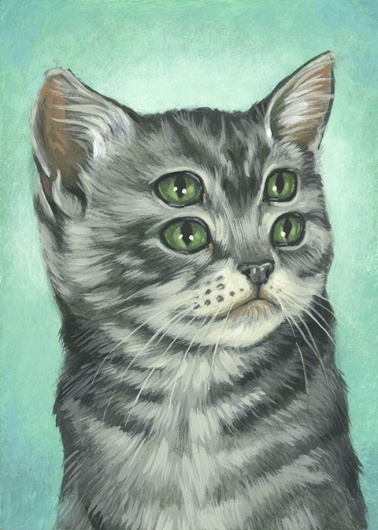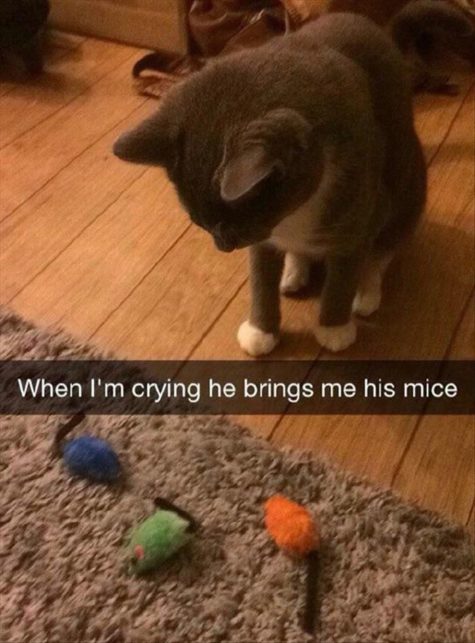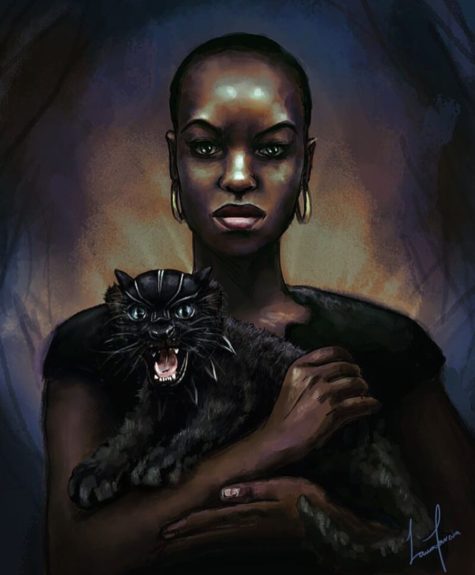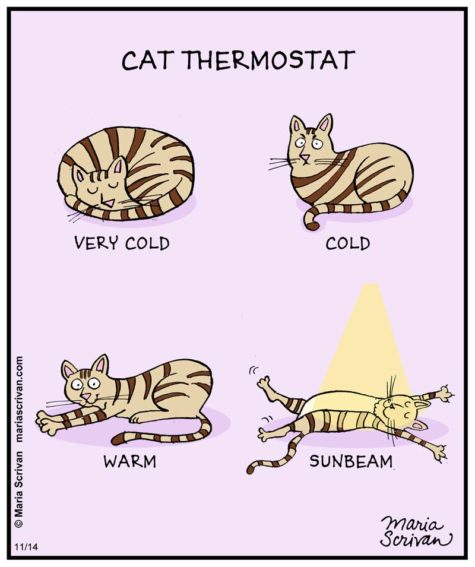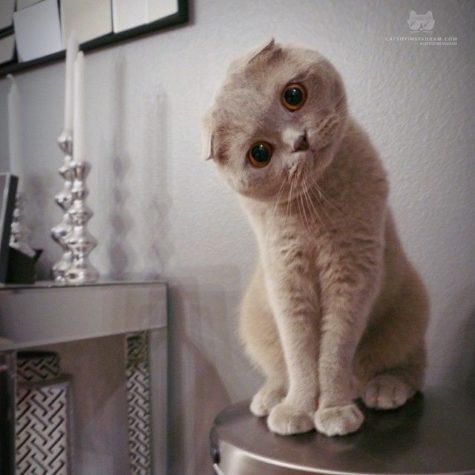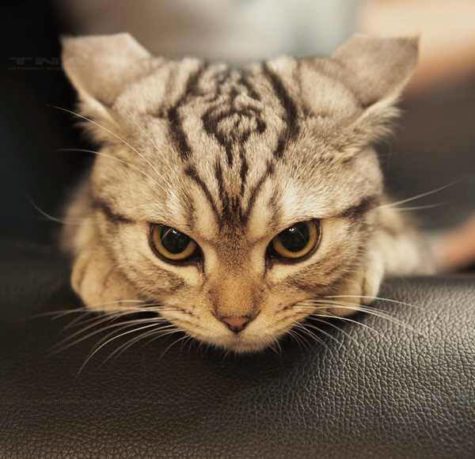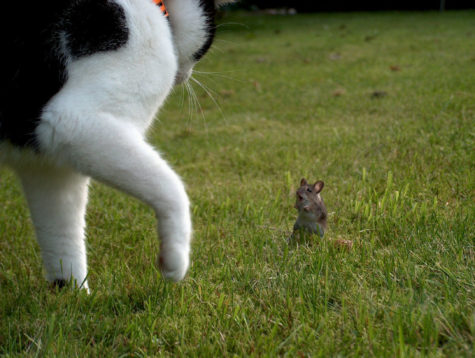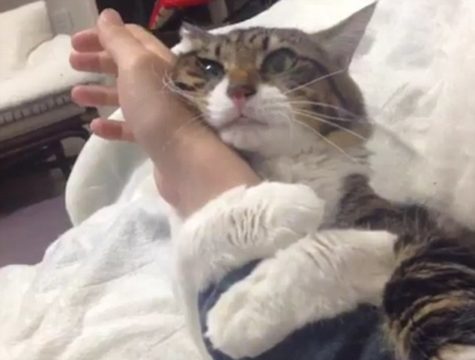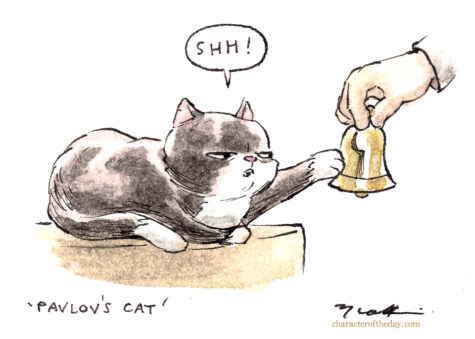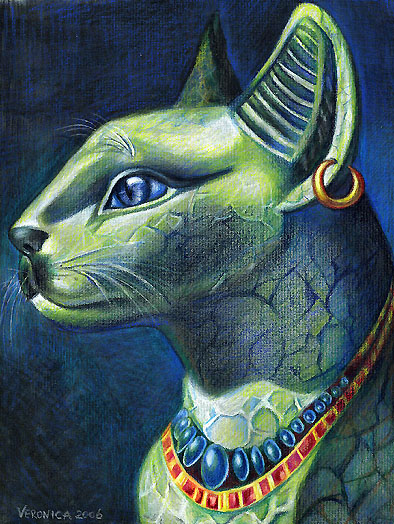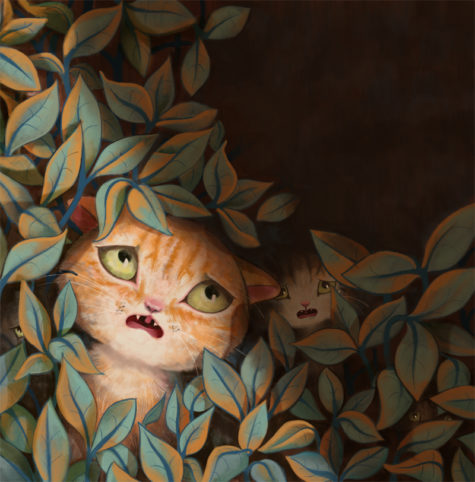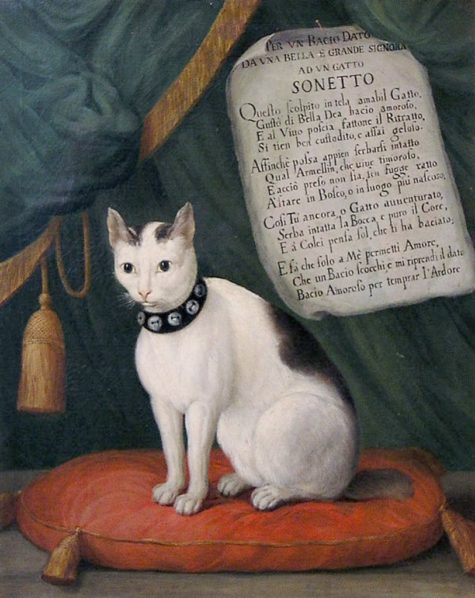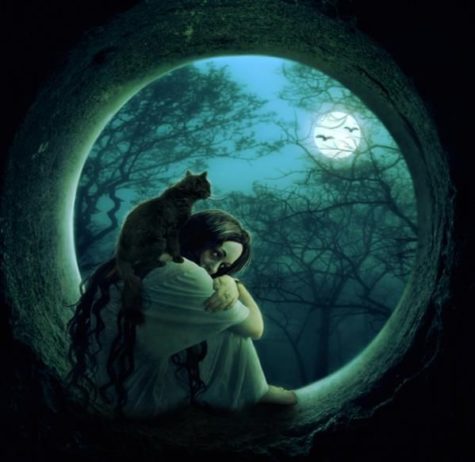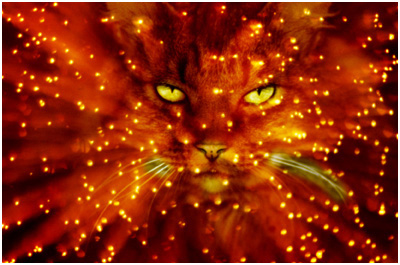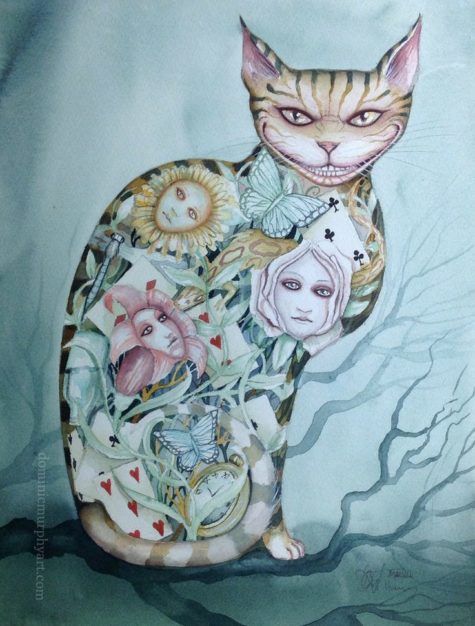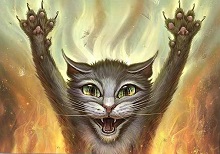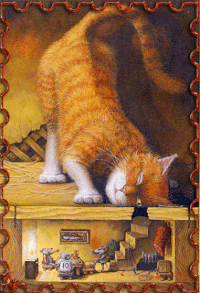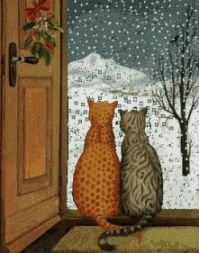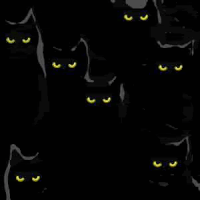shirleytwofeathers
The Four Eyed Cat
It was once generally believed by British fishermen that it is unlucky to take a woman to the fishing grounds, allow a woman onto a fishing boat or even to meet a woman on the way to sea. In some places this taboo extends even to mentioning a woman. This superstition persists in a few areas.
Once there was a gentleman had a beautiful daughter who was bad at heart. It was said that she knew more than a Christian ought and the people thereabouts wanted to swim her. This meant they wanted to test her as a suspected witch by casting her into the water to see if she floated – if she floated it was proof she was a witch, if she sank then she was innocent.
However, no one dared swim the suspected witch because of her father. The girl put a spell on a poor fisherman, and he became so in love with her that he followed her wherever she went. Even though he was engaged to be married that week, he deserted his bride-to-be and ran away to see with the gentleman’s daughter. She did this to spite her proud father, but her father thought himself well rid of the spiteful maid.
The fishermen unwittingly took her out with them to the fishing grounds; the only one that knew she was in a fishing boat was her lover who had hidden there. A great storm blew up and the whole fishing fleet were lost and every man drowned. It was said that she had whistled up the storm. She had even drowned her own lover out of spitefulness. Afterwards, she turned into a four-eyed cat and she continued to haunt the fishing fleet. This is why fishermen will never cast their nets before cock-crow (half-past three) and why they always throw a bit back into the sea to appease the cat.
Found at: Moggycats Cat Pages
Kitty Comfort
African Cat Gods and Lore
Africa has cats. We all know that. The problem is that most of the cats of Africa can rip you to shreds without so much as an “if-you-please.” Sure, Egypt and their adored cats were in Africa, but that culture was radically different from those of the remarkably diverse peoples inhabiting the rest of this vast continent.
Big and dangerous cats were everywhere, and I would think that dealing with them would be precarious at best. For instance, imagine how scratched up you can get when performing the marginally difficult task of giving your cat a bath. Now imagine if that cat weighed about 400 pounds like the African Lion. And lions aren’t the only big African cats; don’t forget cheetahs and leopards.
Fortunately, these magnificent creatures usually won’t harm humans unless they are starving or terrified. The indigenous people of Africa have nothing but the respect for these big-cats (and indeed all animals) and their ancient myths and legends are filled with the exploits of these creatures.
But there was one African cat that wasn’t so big. To the Africans it was just another cat, albeit, a smaller one. We’ve given it the scientific name Felis Libyca or simply the African wildcat. Around 4497 years ago (c.3000 B.C. ) this wildcat made its way through Ethiopia and up into Egypt. These are believed to be the very cats that the Egyptians domesticated.
While we’re on the subject, the cat we all know and love today is descended from the pairing of the African wildcat Felis Libyca and the European wildcat Felis Silvestris, (do you suppose this where the cartoon Sylvester got his name?) And just in case you are burning with curiosity, that adorable pussycat all snuggled nicely in your lap is designated Felis Catus.
So next time you happen to be studying the behavior of your cat, remember its rich African heritage. And if you are looking for an interesting and unusual magickal name for your cat, you might consider the following:
- AGASSOU (Ah-Gahs’-Oo) Panther Fetish of the Dahomey tribes. Male or Female:
Dahomey (now called Benin), is a country along the West Central coast of Africa, founded by the Yoruba tribe of Ife in the 12th century. Over time this region was settled by people known as the Edo and the Fon. Within this rather small district, four kingdoms arose, the mightiest of which was Abomey. Dahomey was well known for its fine craftsmanship, being particularly adept in ivory sculpture. A walled city said to be 25 miles in circumference, Dahomey was one of the magnificent jewels of African civilization. Now Agassou wasn’t a god but a fetish, which means an object empowered by spiritual forces. Since the Panther was considered a creature of great power and courage, the figure of Agassou the Panther was assigned as guardian and protector to the king (called the Oba.)
- AKONGO (Ah-Kong’-Go) Male:
There are those cats which enjoy the company of humans and then there are those that do not. If your cat is one of the kind that despises the formalities of social interaction, then listen to this tale from the Ngombe tribe of the Congo. Akongo was the Supreme god.
Being a benevolent, easy going deity he chose to live upon the earth with humanity because he enjoyed working and relaxing alongside them. But things began to grow sour. The humans began complaining and bickering about the most trivial of things. They became more and more self-centered, selfish, greedy and covetous. Where they once enjoyed idyllic pleasures during their time of leisure, they now filled those moments with drunken revelry and obnoxious behavior. Then one day, two of the humans attacked each other.
A violent battle ensued which so disgusted the god Akongo that he left humanity to themselves. He was said to have disappeared into the depths of the jungle, determined to never again associate with people. It is said that he has not been seen since. So if you know of a cat like this, antisocial and preferring solitude, remember the name Akongo.
- AMMA (Ah’-Mah) Male:
This is the Supreme god of the Dogon tribe of Mali. He was something of a misogynist actually, so here’s a name for a neutered cat that really couldn’t care less about females. Why was Amma such a misogynist? Well, being the supreme god, naturally he created the world and the universe. They say he created the stars by tossing dirt clods into the sky.
Next, he decided that he would create a woman so he could breed. He made this woman, also from clay. She was the earth. But one thing bothered Amma. Upon the surface of the newly formed earth grew a termite mound. This was in fact her clitoris. Fearing that this might prove to be a sign of a competing masculinity, the god had it severed, believing that in doing so he would make her 100% woman.
An awful story, I know, but to this day some African peoples still practice a form of female circumcision called clitoridectomy. Whether or not this has anything to do with the myth is uncertain.
- ANANSI (Ah-Nahn’-See) Male:
To the Ashanti culture he is one of the most important heroes and is the primary character in many of their myths. Even though you may not have heard of this god, there is one tale about him with which I’m sure you’re familiar.
It’s a rather long, complicated story, but the gist of it is Anansi must gather several items for the sky god Nyankopon. This he does in his prank-laden style. The last item he had to collect was a nature spirit, most elusive elementals indeed. Of course Anansi had a plan. He molded a figure of a person out of an extremely sticky resin and placed it on a rock where he knew the nature spirits often passed. Near the figure he placed a dish of food.
Before long, one of these nature elementals came by and noticed the food. The spirit asked if it could have a taste, but naturally the figure did not reply. Thinking the “person” was being disrespectful and rude, the elemental slugged the figure as hard as he could. Much to his surprise, his hand became caught in the resin. Panicking, the spirit hit the figure with his free hand and then kicked it and finally butted it with its head. With each movement the spirit became more and more stuck in the gooey tree sap until he was absolutely unable to move.
At this point Anansi approached the hopelessly trapped elemental and placed him in a sack to make his delivery. If you haven’t recognized the story by now, then you’ve never heard any of the American folk tales attributed to a fictional slave named “Uncle Remus.” This African legend is in fact the source for the story of Brer Rabbit and the tar baby. Since many cats are known for their mischievous antics and behavior that might even be construed as deliberate pranks, keep the name Anansi in mind.
- BUMBA (Boom’-Bah) Male:
Cats will at sometime in their lives throw up hair balls. No big deal, it’s just a fact of feline existence. If your cat seems to be hacking them up continuously, then this god name with its odd little tale might be appropriate.
Bumba is another one of those creator gods, this time of the Bushongo people of the Congo. How this god created the world is disgusting to say the least since he vomited up the stars, the sun, the moon, everything in fact. He then created (or vomited) Heaven and Earth who were supposed to live together as a married couple. Things didn’t work out and Heaven decided to leave for good. They have been divided ever since. Reunification is only possible when the material Earth ceases, which actually means when WE cease.
- FAMIEN (Fah’-Meen) Male:
Cats are often associated with witches and wizards and such. Some say that the reason for this is due to their unique ability to absorb evil influences and repel negative energies. Perhaps you’ve discovered this feline trait yourself through observing the protective behavior of your own cat.
If so, then Famien might be just the name for your guardian mouser. Famien was the fertility god of Guinea, but besides that he was also the preeminent luminary against demons and dark sorcerers. If that wasn’t enough, he was also the supreme lord of good health. A name that resonates with favorable luck.
- GUNAB (Goo’-Nab) Male:
For some reason this god of the Hottentot was considered an evil force, even though he is said to have created the rainbow. He was known to make dark rock quarries his domicile, so maybe if your cat likes dark hiding places this would make a suitable name.
- GURUHI (Goo-Roo’-Hee) Male:
Here’s an appropriate name for a spoiled and moody cat, prone to insisting upon selfish demands. Guruhi is another evil god, this time from Gambia. He was a most demanding and vengeful god. However, to his worshipers he bestowed great powers, providing they offered him the right kind of blood sacrifice, that is. Those uninitiated to his cult were forbidden even to gaze upon him, and Guruhi took great delight in torturing those foolish enough to ignore this rule.
- HEVIOSSO (Heh-Vee-Oh’-So) Male:
There are some cats that are content to simply relax in the window sill enjoying the sunshine. Then there are the cats that have to tear apart everything in sight, sparing neither couch nor curtain from their razor sharp claws. If this sounds familiar to you, you may consider naming your destructive kitty after the Dahomey god of thunder, Heviosso.
Besides the usual chaotic attributes which you would expect to accompany a thunder god, there is a very curious ritual performed in his honor by troupes of ceremonial dancers that explains why this name fits a ruinous kitty so well.
During his rites, the dancers of Heviosso make thunder-noises while engaging in wild movements representing the thunder god’s sexual union with the earth. These dancers froth themselves up into such turmoil that they begin wrecking everything and anything including their own homes. They tear apart bushes and vegetation. They assault innocent spectators. They’ve even been known to raze the various sacred sites to the ground. And just think, all this could be avoided if only they had a really big scratching post.
- KALUMBA (Kah-Loom’-Bah) Male:
Kalumba was the god of creation to the Luba tribe of Zaire. Cat fanciers can appreciate one story concerning this god, if only because it makes dogs look so stupid. As the tale goes, Kalumba noticed the forces of Life and Death, casually strolling down a dirt path toward the world of the creatures called men whom he had only recently created. To insure that his creations would be allowed to flourish, Kalumba posted Dog and Goat in the middle of the road with orders to let Life pass while apprehending Death.
Once Goat and Dog were in place, they started bickering about which one of them would do the best job by staying awake the longest. Goat left Dog alone, just out of spite. So, all alone, Dog did his best to keep a vigilant watch, but to no avail. Dog fell sound asleep and while deep in slumber, Death walked right on by and entered the world of man.
Well, the next day Goat returned to relieve Dog who quickly departed in shame. Determined not to be as foolish as Dog, Goat forced himself to stay wide awake. Eventually he spotted Life coming on down the road and promptly detained him. Thus it was that Life was prevented from passing to the world of men, giving Death free reign. Of course things would have been a lot different had Kalumba posted cats on that road. Especially if they were BIG cats.
- KOKOLA (Koh-Koh-Lah’) Male:
This god was supposed to keep watch over precious items and valued possessions. Legends say that he lived in a cave near the banks of Lake Victoria. It was to this cave that various articles in need of protection were brought, kind of like a rock-hewn safety deposit vault.
Now I’m sure we all know of a cat that is a bit overprotective of one thing or another. It could be a particular food-dish, a treasured catnip toy, or even a favorite place to sit. By exhibiting such behavior, the cat may very well be imitating some trace remnant of Kokola’s guardian tendencies.
- KYALA (Kye-Ah’-Lah) Male:
This is the creator god to the Nyakyusa tribe of Tanzania. He started off as a simple provincial god then made his way up to the king-sky god. He became so vainglorious as a result of his rise to power that he demanded an instant cessation in devotions from those who worshipped him. He decided that he was just too significant to be dealing with trivial little creatures like humans. Got a stuck-up feline who thinks his litter box doesn’t stink? Then here’s the consummate name.
- LEGBA (Leg’-Bah) Male:
Keep in mind, Legba is considered an evil god by the Dahomey. You may recognize his name if you are familiar with the practice of voudon or voodoo, for this African god was the original form which was later adopted by the Haitians. Evil god that he was, the Africans still paid him homage by offering preventative sacrifices more or less as a means of keeping him away. These sacrifices were often small goats, usually offered during the rites to HEVIOSSO.
Legba was also represented by small clay figurines which every tribe member kept near their home. These figures were tended to regularly by offering food and often a sacrificed chicken in an effort to satiate the dark god. I only include this name because, after all, not everyone’s cat is a saint.
- LISA (Lee’-Sah) Female:
Finally, a female name for a change. Lisa (also known as Leza or Lissa) is the chameleon god of the Dahomey. She is often associated with the chief god MAWU. Together with their son Ge (god of the moon), they form one of the many triads found in mythologies the world over. Actually, Lisa could be either a god or a goddess–something of a divine androgen. In her female state she is considered goddess of chameleons because it is told that she sent these creatures as helpmates to those humans engaged in expanding her sect.
With that in mind, I can think of two situations where one might name their cat after this chameleon goddess. First, since calico cats are a virtual potpourri of colors, the chameleon motif works nicely. Then there are those cats with fluctuating behavioral patterns that range from moody to content to wild back to moody again.
If you pay close attention, you might find that your cat is merely reflecting your own state of mind. If so, then this goddess’s common sounding name would truly fit the chameleon-like traits of your uncommon cat.
- MAWU (Mah’-Woo) Male:
We’ve already touched on Mawu and his relationship with the androgynous LISA, but it should be pointed out that he has a bit of an androgynous nature himself. To some of the Dahomey tribes Mawu remains the chief of the gods, but some tribes in West Africa consider Mawu to be the goddess of the moon. Then too, the Dahomey tribes often unify Mawu and Lisa into a male/female god named, oddly enough, Mawu-Lisa, the progenitor of all Dahomey gods.
Regardless, he is most often thought of as the creator. With Lisa and their son Ge, they form an important triad not unlike that of Egypt’s ISIS, OSIRIS, and HORUS. All this can be confusing enough as it is, so let’s leave out the part where Mawu (the moon goddess version) gives birth to a male form of Lisa (now considered a sun god) to form a unified King of the Gods. Here’s a good name for a sexually ambivalent cat, male or female. Besides, don’t you think Mawu sounds kind of like “meow”?
- MULUKU (Muh-Loo’-Koo) Male:
Another Supreme god, this time from Zambesi. The story goes that after making the earth, Muluku decided to dig two holes deep into the newly created soil. Soon a human male crawled out of one hole, while out of the other hole climbed a human female.
Right away, Muluku set to organizing these new creatures by providing them with tools and seeds with which they might begin to cultivate the land. He gave them instructions on using the tools and on the various seeds to plant. He showed them how they might build shelter and how they were to prepare the harvests which the seeds would soon yield.
Unfortunately none of this seemed to mean much to the new humans. They ate the seeds raw, tossed the tools all about making a big mess and then headed off toward the forest where they both hid in the trees. Needless to say, this irked the god to no end. As an experiment Muluku called two monkeys, a male and a female, and just for kicks gave them identical tools, seeds and instructions.
Well, the monkeys wasted no time. They planted, they worked, they built their shelters, and in time they harvested the food and even used a few of the recipes that Muluku had so thoughtfully suggested. Learning what he had set out to discover, the god knew just what his next move would be. Cutting off the tails of his two monkey friends, Muluku quickly attached them to the two foolish humans still hiding in the trees.
So it was that the original humans became monkeys and the original monkeys became humans. There is a very important message in this whimsical legend, though I have no idea what it is. Since Muluku was both a creator god and a harvest god, this name might suit a country-cat, at home in the corn and the wheat. If not, well then you’re on your own with this one.
- MUNGO (Muhn’-Goh) Male:
Here is a name that recalls the cat “Mungojerry” of T.S. Eliot fame. Actually, Mungo was the rain god of the Giryama of Kenya. To get him to send rain, what you do is sacrifice a goat along with a chicken, beat on the horn of a water buffalo while asking Mungo to send precipitation, then tie a white sheet to the roof of your house. As if through a miracle, it will begin raining! Well, eventually anyhow. Name your cat Mungo if he happens to love staring out the window on dark and drizzly days.
- NAMPA (Nahm’-Pah) Male:
Does your cat have a problem with hairballs? What cat doesn’t? Of course some cats have more of a problem than others, so if your kitty happens to be one of those chronic hairball types, Nampa may be just the name for you.
Nampa was more of a spirit than a god. To the people of Senegal he is represented as a fetish composed of pulped roots and leaves which are then, you guessed it, rolled into little balls. That’s about all the information I could get on him since only the elite get to worship him and that they do in utmost secrecy.
- NYAMBE (Nigh-Ahm’-Bee) Male:
There are actually two gods with this same name or a variation of it (Nyambi.) One is the Nyambe of the Koko tribe in Nigeria. To the Koko, he was the god of regeneration. He lived on the earth with humans and provided them with immortality through the agency of one very special, life-giving tree. But the people began to take this beneficent god for granted. This hurt Nyambe very much.
One day he called the people to gather around. When they had assembled, the god took a bundle of twigs and asked if any man was strong enough to break them. Many tried that day, but no one succeeded. Nyambe then pointed out that when the twigs were released from the bundle, they broke quite easily. He explained that when they had bound themselves to him, they had strength and nothing could take that from them, but now that they distanced themselves from him, they were alone and weak. With that, Nyambe pulled the tree of immortality from the ground and disappeared forever. It wasn’t long after this that people began to die.
The other Nyambe hails from the Barotse tribe of Upper Zambesi. His tale is interesting in that it is one of many African legends which, from tribe to tribe, speak of man’s foolishness in attempting to reach god by constructing a tower to the heavens. Sound familiar?
Anyway, this legend reads more like an old Warner Brother’s cartoon, with Nyambe being chased around the globe by a whining human named Kamonu. Kamonu was full of petty requests which the god always fulfilled. Then one day, the god had reached his limit. Unfortunately, that was the day that Kamonu’s child died.
For the first time the god’s help was needed for something really important, so Kamonu tracked Nyambe down and begged his assistance. But the god wouldn’t listen and ran away into the forest. No sooner had Nyambe settled down in the forest than he noticed Kamonu only a few steps away. The god ran off to a secluded cave, where, who should be waiting for him but Kamonu. Nyambe, stunned by the sight, ran to the top of the world’s highest mountain only to find Kamonu there already. Eventually Nyambe was able to get completely away.
Undaunted, the indefatigable Kamonu built himself a tower just as high as he possibly could. It is said that Kamonu sits upon his tower to this very day, greeting the sun and the moon as they make their passage across the sky, and that he shall continue to sit there for all eternity, hoping one day he will be allowed to see Nyambe again. In both stories you’ll notice the god’s desire to shun human society, so consider that should you be trying to think of the right name for an adopted feral cat.
- NZAMBI (Nah-Zahm’-Bee) Female:
Another female! Nzambi was the great goddess of creation to the Bakongo tribe of the Congo. She was said to have walked the world of men disguised as a filthy old beggar woman, pleading for help wherever she went. To those who assisted her she gave great rewards. However, those who offered her nothing but scorn were severely punished and learned a very hard lesson about charity. This is only one example of her style. She was known for bestowing grace or scrutiny to individuals based upon their virtues or faults, respectively. A fitting name for one of those slovenly street cats that turn out to be much more than they might have at first appeared.
- OGUN (Oh’-Guhn) Male:
The West African tribes of the Nago and Yoruba recognize Ogun as the god of iron and warfare. Since he is the god of iron, he is the patron of forgemen and metalworkers. It makes sense then that he is also the god of war when you consider the weaponry crafted by these artisans. As for Ogun himself, his weapon of choice is the machete.
This god and his machete have become symbols of clearing away difficulties, and to this end they are often evoked. This is the result of a story wherein the legendary gods first come to the earth, only to find the entire planet covered with dense thorn bushes and other barriers of wild vegetation. Rising to the occasion, Ogun used his machete to cut a pathway for his fellow deities.
Since then he has been called upon to lend his helping hand by those seeking assistance in achieving their goals. Perhaps this is also how he got his reputation as a war god. As a cat name Ogun might be good for a fighting tom, but on a more civilized note you might give this name to an emotionally beneficial cat.
- OMUMBO-ROMBONGA (Oh-Muhm’-Boh Rohm-Bong’-Gah) Male or Female:
This name doesn’t belong to a god, a devil, or even a spirit. This is the name of the tree from which all human beings were born, according to the Herero Bushmen of South West Africa. It is also the source from which many other animals originated. Because of this, it is believed that humans and animals once spoke a common language having been born from the same tree. Sadly, this language has been long forgotten by human beings. Omumbo-Rombonga is a lot easier to pronounce than it may look and makes a great name for tree-loving cats of either sex.
- RUWA (Roo’-Wah) Male:
Sometimes myths from vastly diverse cultures share common details and motifs as in the following story from the Djaga tribe of Kilimanjaro. Ruwa was the supreme god, though he had more to do with the management of creation than with actually creating it.
He had recently freed the humans from that big pot where they had been kept prisoner and now he was preparing a garden where they could live in peace. He filled this garden with all sorts of fruit bearing trees, and in the middle he placed a sacred yam which was forbidden to the humans.
Everything went just fine for a long time, but then one day an odd looking beggar came to the garden in search of food. He was offered as much of the garden’s fruits as he wished, but he claimed to have met Ruwa on the way to the garden and said that the god had told him it was time to eat the sacred yam. Without a moment’s hesitation the people pulled that yam from the middle of the garden and began to cook it with great celebration.
Soon the scent of the yam filled the air, and it wasn’t long before the smell reached heaven. Catching a slight whiff of the forbidden yam, Ruwa dashed down to the garden. There he saw the humans whooping it up, doing exactly what he had told them not to do. The god was understandably upset, especially since the word of a stranger had been followed rather than his own explicit orders.
Taking what was left of his sacred yam, Ruwa went back to heaven leaving the humans with a new susceptibility to something called death. Nothing particularly cat-like seems to be in this interesting tale, but has that ever stopped us before from finding some half-baked reason to use a name for your cat? Of course not! Use this name for an arbitrarily demanding feline with very little sense of humor.
- SHANGO (Shahn’-Goh) Male:
To the Yoruba of West Africa, Shango is the god of storms, thunder, and lightning. He carries a thunderbolt which is often symbolically rendered as an ax. In this regard he is very close to the Nordic god Thor. A good name for an extremely sharp, lightning fast cat with a volatile personality.
- WAKA (Wah’-Kah) Male:
Another rain god. But to the Galla of Ethiopia, Waka is much more than a rain god. He is also the god of rituals and ceremony. Keep this name in mind if your cat is of an ordered, mystic nature.
- WULBARI (Wool-Bahr’-Ee) Male:
Supreme god of the Krachi from West Africa. There is an odd story concerning this eccentric deity and the trickster god ANANSI. Among the animals invited to dwell in the heavenly court was Anansi, the tricky spider god. Being something of a braggart, Anansi started getting on Wulbari’s nerves. He boasted that he was much more clever than the supreme god.
To Wulbari, this just wouldn’t do. One evening the mighty god summoned the various animals to witness the presentation of a challenge to Anansi. If the trickster god could simply leave heaven for awhile and return with “something” then Wulbari would concede that the trickster god was indeed far more clever than he. There was a catch however. Wulbari wouldn’t say what the “something” was.
Accepting the challenge, Anansi left the court and promptly constructed himself a bird-suit disguise from various feathers he collected. Wulbari himself, so certain that Anansi was far away by now, blurted out that the “something” he was thinking of was the Sun, the Moon and total darkness.
Anansi, hearing this while disguised as a bird ,now knew exactly what the “something” was. Anansi came back with a sack and upon its opening, out escaped total darkness. Unable to see a thing, the other creatures fumbled about in complete chaos. Then the trickster god opened the sack again and released the Moon. That was slightly better. At least now there was a dim light in the sky. But then without warning, Anansi pulled out the brilliant Sun. This stunned everyone since their eyes had adjusted to the soft light of the Moon.
Many of the animals present were blinded by this surprise, and Wulbari was forced to admit that the trickster god had won the challenge. This tale is supposed to explain how blindness came into the world, so if you are the unfortunate owner of a blind cat (it does happen you know), then I guess this name might be appropriate. But since we all know how well cats maneuver in darkness, I think you can name any cat Wulbari in commemoration of this unusual incident.
Found at: Lowchen’s Australia
It’s A Cat Thermostat
A Cat’s Guide To Humans
Introduction: Why Do We Need Humans?
So you’ve decided to get yourself a human being. In doing so, you’ve joined the millions of other cats who have acquired these strange and often frustrating creatures. There will be any number of times, during the course of your association with humans, when you will wonder why you have bothered to grace them with your presence. What’s so great about humans, anyway? Why not just hang around with other cats?
Our greatest philosophers have struggled with this question for centuries, but the answer is actually rather simple: They Have Opposable Thumbs. This single attribute makes them the perfect tools for such tasks as opening doors, getting the lids off of cat food cans, changing television stations and other activities that we, despite our other obvious advantages, find difficult to do ourselves. True, chimps, orangutans and lemurs also have opposable thumbs, but they are nowhere as easy to train and their incomes are limited.
How And When to Get Your Human’s Attention
Humans often erroneously assume that there are other, more important activities than taking care of your immediate needs, such as conducting business, spending time with their families or even sleeping. Though this is dreadfully inconvenient, you can make this work to your advantage by pestering your human at the moment it is the busiest. It is usually so flustered that it will do whatever you want it to do, just to get you out of its hair. Not coincidentally, human teenagers follow this same practice.
Here are some tried and trusted methods for getting your human to do what you want:
- Sitting on paper:
An oldie but a goodie. If a human has paper in front of it, chances are good it’s something they assume is more important than you. They will often offer you a snack to lure you away. Establish your supremacy over this wood pulp product at every opportunity. This practice also works well with computer keyboards, remote controls, car keys and small children.
- Waking your human at odd hours:
A cat’s “golden time” is between 3:30 and 4:30 in the morning. If you paw at your human’s sleeping face during this time, you have a better than even chance that it will get up and, in an incoherent haze, do exactly what you want. You may actually have to scratch deep sleepers to get their attention. Remember to vary the scratch site to keep the human from getting suspicious.
Punishing Your Human Being
Sometimes, despite your best training efforts, your human will stubbornly resist bending to your whim. In these extreme circumstances, you may have to punish your human. Obvious punishments, such as scratching furniture or eating household plants, are likely to backfire. Being unsophisticated creatures, humans are likely to misinterpret these activities and then try to discipline YOU. Instead, we offer these subtle but nonetheless effective alternatives:
- Use the cat box during an important formal dinner.
- Stare impassively at your human while it is attempting a romantic interlude.
- Stand over an important piece of electronic equipment and feign a hairball attack.
- After your human has watched a particularly disturbing horror film, stand by the hall cupboard and then slowly back away, hissing and yowling.
- While your human is sleeping, lie on its face.
Rewarding Your Human: Should Your Gift Still Be Alive?
The cat world is divided over the etiquette of presenting humans with the thoughtful gift of a recently disembowelled animal. Some believe that humans prefer these gifts already dead, while others maintain that humans enjoy a slowly expiring cricket or rodent just as much as we do, given their jumpy and playful movements in picking the creatures up after they’ve been presented.
After much consideration of the human psyche, we recommend the following: cold blooded animals (large insects, frogs, lizards, slow-worms, grass snakes and the occasional earthworm) should be presented dead, while warm blooded animals (birds, rodents, your neighbor’s Chihuahua) are better still living. When you see the expression on your human’s face, you’ll know it’s worth it.
How Long Should You Keep Your Human?
You are only obliged to your human for one of your lives. The other eight are up to you. We recommend mixing and matching, though in the end, most humans (at least the ones that are worth living with) are pretty much the same. But what do you expect? They’re humans, after all. Opposable thumbs will only take you so far.
Found at: Moggycats Cat Pages
Simon’s Cat Finds Something To Do

Looks like Simon’s cat has found something fun to do.
🙂
Pavlov’s Cats
Everyone has heard of Pavlov’s Dogs and many have heard of Schroedingers Cat. But what of Shroedinger’s Dog and Pavlov’s Cats?
Let’s not concern ourselves with Shroedinger’s Dog, a creature so incredibly stupid and perpetually confused it has difficulty being in one state at a time let alone being in two states simultaneously. When put into a box with a decaying vial of poison which might or might not release the poison, Shroedinger’s Dog chews the vial thus ensuring it ended up in a dead state every time.
Pavlov’s Cats is a far more interesting a subtle experiment into feline-human behaviour. Pavlov was a Welsh behavioural scientist who conducted experiments into ringing bells and cats eating food. His experiments went something along the lines of:
- Day 1: Rang bell. Cat buggered off.
- Day 2: Rang bell. Cat buggered off.
- Day 3: Rang bell, but cat put paw on bell so it only made a ‘thunk’ sound.
- Day 4: Rang bell, cat said he’d eaten earlier.
- Day 5: Tried to ring bell, but cat had taken batteries out of bell.
- Day 6: Cat rang bell. I ate food.
Sure enough, the Pavlov’s Cat experiment proves that scientists can be conditioned to eat cat food and that cats eat only when it suits them. Many scientific discoveries have been made accidentally while trying ot prove something entirely different.
The experiment might have worked had the cat not been buggering off to next door where it had already conditions Pavlov’s neighbor to give it a nice plate of chicken liver. Who knows, it might even have rung the bell and conditioned him to open the door as well, just like my cat has conditioned me …
Pavlov’s second attempt, with new cat possibly went something like this:
- Day 1: Rang bell. Cat (white) asleep.
- Day 2: Rang bell. Cat (white) rolled over and snored.
- Day 3: Rang bell. Cat opened eye (blue), yawned, complained about cheap brand of cat food.
- Day 4: Rang bell. After 4 hour delay, cat woke up, ate food, went back to sleep.
- Day 5: Read article about deaf blue-eyed white cats.
- Day 6: Cat woke me up by sitting on head. Fed cat. Bought dog. Dog drools.
From: Moggy Cats Cat Pages
The History Of The Domestic Cat
Our English word “cat” doesn’t seem to have come into general usage until around 300 A.D., give or take a few decades or so. It is interesting to note that several of the world’s languages call this animal by a name very similar to the English words “cat” or “puss” (which itself is believed to have derived from the name of the ancient Egyptian goddess Pasht, a cat-headed deity who was considered a darker manifestation of Bast; a.k.a.Bastet, acknowledged as the Mother of ALL cats and a goddess).
For instance, all the following examples are the words for the creature we call “cat”:
- French ~ Chat
- Welsh ~ Cath
- Arabic ~ Kitt
- Polish ~ Kot
- Syrian ~ Kato
- Sanskrit ~ Puccha
- Persia ~ Pushak
- Italian ~ Gatto
- Spanish ~ Gato
- Lithuanian ~ Puize
- German ~ Katze
- Russian ~ Kots
- Irish ~ Pus
As for the Egyptians, they called the creature Mau, meaning “to see.” No doubt the name also made onomatopoetic reference to the cat’s familiar meowing. No one really knows for certain, but it is believed that the cat may have been domesticated by these ancient Egyptians 4,000 to 5,000 years ago; relatively recent when you consider that the dog has been a companion to humans for 20,000 years, perhaps even longer. Some experts theorize that this human/dog relationship may have been going on as long as 50,000 years. As a result, the cat has retained many of its natural instincts and behaviors, having only been among humans a short while, whereas dogs have evolved right alongside us for quite some time now.
There is something about their confident personality that we admire. In fact, the ancient Egyptians were so fascinated by this detached quality of the cat that they considered them to be nothing less than godlike. To the Egyptians all cats were divine, and extreme behavior was often acted out to reinforce this conviction. For instance, if a someone happened to come across a dead cat in the street, he or she would put on a loud display of sorrow and mourning just to make sure no one thought that they were responsible for killing the cat. You see, according to Egyptian law, being found guilty of cat murder was punishable by death.
Whenever a household cat died of natural causes, the entire family would go through a period of grief, shaving their eyebrows as a mark of their sadness. Deceased cats were very often mummified and entombed with fine jewelry and treasures; a custom usually reserved for only the most powerful and wealthy of the ruling class.
But by far, the most fanatical demonstration of Egypt’s devotion to her cats occurred in 500 B.C.2 during a period of warfare with Persia. At the city of Pelusium, the Persian and Egyptian armies engaged in fierce combat, but the Egyptians resisted the onslaught with a fixed determination to save their city. The resolve of the Egyptian war machine proved too much for the rapidly tiring Persian army. Sensing ruinous defeat if the battle continued, the Persians retreated while they still could. The Egyptians knew that this wouldn’t be the end of it, so the army maintained a condition of battle readiness, waiting for the Persians to return.
What the Persians were up to was a brilliant scheme that displayed a profound understanding of their enemy’s culture and beliefs. They discovered a kink in the Egyptian armor, a weakness they would fully exploit. Night after night, the Persians deployed their elite forces to the villages and towns of the surrounding countryside, silently capturing as many cats as they could lay their hands upon. Once satisfied with the number of animals they’d collected, the Persian army returned to the city of Pelusium.
The Egyptians first noticed the distant clouds of dust, kicked up by the approaching Persian army, at dawn. The troops were readied for battle in an orderly manner, well rested and ready for combat.
Within an hour, the two armies positioned themselves in assembled ranks, glaring at each other across the battlefield. The Egyptian General signaled for the attack. In an instant, the Egyptian army charged upon the Persians who, oddly enough, held their ground. The Egyptians roared like thunder as they rapidly advanced on the Persian front line. Suddenly, there was movement within the Persian forces. Curious, but undaunted, the Egyptians continued their charge.
Then, they saw a sight that nearly froze them in their tracks. Hundreds of panic stricken cats were released upon the battlefield. The Egyptian army watched in horror as the sacred animals ran about in deadly fear.
Confusion spread through the Egyptian ranks as the Persian army seized the opportunity to take the aggressive. Advancing upon the stunned Egyptians in a evenly paced march, each of the Persian soldiers held forth a terrified cat. The Egyptians knew then and there that they were defeated.
Not a single Egyptian soldier dared to engage the enemy, fearing that to do so might endanger the lives of the cats. Without suffering a single casualty, the Persians secured their victory, devastating the Egyptians.
It has been suggested that the Egyptians initially used the cat to control the rodent population which continually destroyed crops. This seems to be a reasonable speculation, but it’s obvious that the cat meant much more to the Egyptians than that. Kingdoms don’t loose wars merely for the sake of four-legged mousetraps.
Certainly, something of the cat’s behavior suggested that a very powerful spiritual connection existed between humans, cats, and the gods. The Pharaohs and the priests alike were quite protective of their honored feline population. The distribution of cats throughout the Kingdom was carefully regulated, while exportation of cats was absolutely forbidden. Since the cat insured agricultural security by keeping away harmful pests, a surplus of goods was able to develop which gave Egypt wealth and strength, and plenty of economic clout when it came to dealing with other countries. No wonder they guarded these animals so closely. The domesticated cat was nothing less than a priceless secret weapon that contributed immeasurably to the greatness of ancient Egypt.
But eventually domesticated cats did find their way out of Egypt thanks to the Greeks who stole the animals to control their own rodent problem, and to use as powerful bargaining chips in international trade. This didn’t go over so well with the Egyptians. In fact, one Pharaoh sent out his army to various lands in a futile effort to recapture the liberated felines and return them home to Egypt.
Unfortunately for the Egyptians, it was too late. Warfare and trade had resulted in the distribution of domesticated cats throughout the Mediterranean and perhaps by this time, even as far as Asia. The Egyptian monopoly on domestic cats had at last come to an end.
Phoenician cargo ships are thought to have brought the first domesticated cats to the European continent around 900 B.C. In time, the Romans adopted the cat as a symbol of freedom and liberty. Never quite venerating felines to the extent of the Egyptians, the Romans nevertheless held the cat in high regard, and it is believed that they are responsible for introducing the cat to Britain during the course of their numerous campaigns of conquest in that region.
Over the subsequent centuries, the domesticated cat proliferated throughout Europe, the Middle East, and China. Though no longer worshiped as deities, cats were still honored and appreciated for their mousing abilities no matter where they turned up. By the 11th Century, about the time the Crusades began, cats were in huge demand since the rats were beginning to overrun the cities. Domesticated cats could now be found as far as Scotland.
While their obvious hunting abilities were being put to good use, the domesticated cat retained its mysterious, otherworldly aura of heavenly protector and benefactor.
Catholic Monasteries kept cats as guardians (that is, until the Church decided that they didn’t like cats anymore); Sailors would bring along cats during long sea voyages believing they possessed miraculous powers to protect them from dangerous weather; in a very short time, the cat spread throughout the world, becoming a treasured companion and friend.
All seemed well for these cats and the people that loved them, for a good long time in fact. Unfortunately, this was not to last. By the close of the 15th Century, Pope Innocent VIII decided that adulation for cats was tantamount to pagan worship in defiance of God. This led to the belief that cats were evil, existing solely to mislead and destroy the faithful.
The Inquisition was given instructions to hunt down all cat owners and try them as heretics and witches. For a while, cats were burned to death by the hundreds, right along side their human caretakers. The crime: “consorting with demonic forces.”
It was a far cry from their exalted days in ancient Egypt.
But cats persevered. In fact, they flourished. Centuries passed as people of various cultures spread diverse influences across the globe, while the stoic cat accompanied this progress each step of the way. And through it all, the cat has thankfully retained its independent qualities, its silent contemplative nature, its persona of supernatural wisdom.
Obviously cats won’t be leaving the scene anytime soon. They are very much a part of our our consciousness, both culturally and spiritually. Their traits are often used to describe human activities. To comment on their independence is nothing more than a safe cliché. Being such an ubiquitous animal, we tend to take them for granted, but remember this: They are the descendants of temple dwelling cats, domesticated by the Egyptians and regarded as sacred. To ignore their unique lineage is to sever all metaphorical links to our mystic past, and this would indeed be a tragedy.
Found at: Low Chen’s Australia
